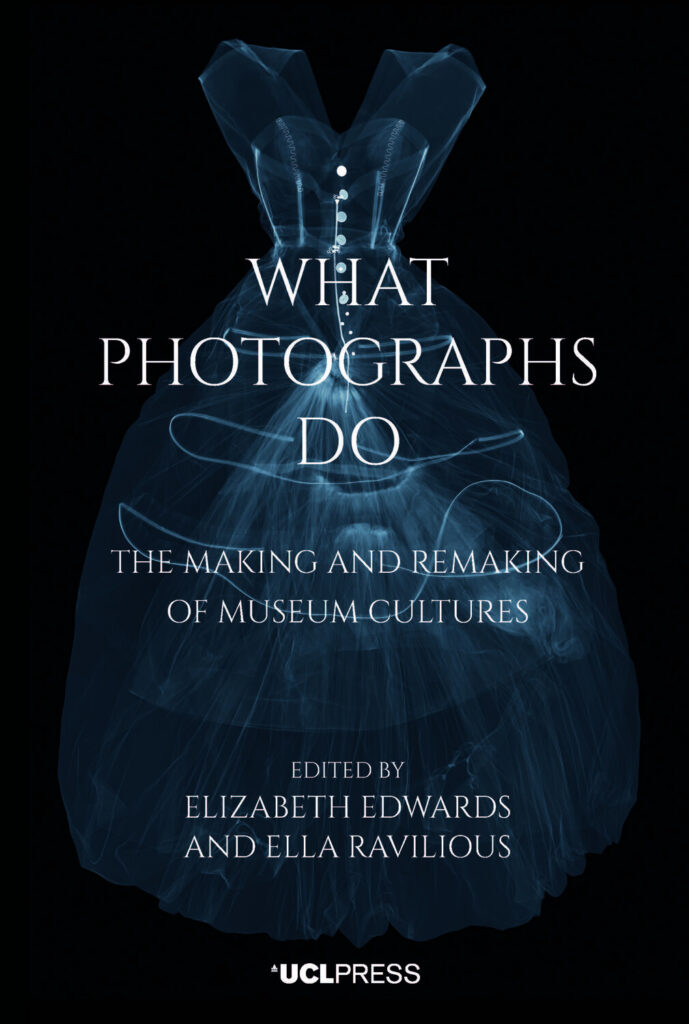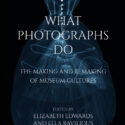Book review: What Photographs Do: The Making and Remaking of Museum Cultures
Edited by Elizabeth Edwards and Ella Ravilious (UCL Press, 2022)
Article DOI: https://dx.doi.org/10.15180/232001
Keywords
book review, Elizabeth Edwards, Ella Ravilious, UCL Press, What Photographs Do
Photographs saturate our lives. They are in our phones, on our walls, packed away in boxes, and stuffed into every nook and cranny of museums, galleries and libraries. What Photographs Do, explores the various lives and locations of photographic materials and practices in one large and longstanding museum in the UK – the Victoria and Albert Museum (V&A).
This edited volume, by Elizabeth Edwards and Ella Ravilious, brings together voices from inside museum practice who don’t often have space to share their experiences within typical academic conferences and publications. What Photographs Do, combines recent and urgent questions in the history of photography and museum practice with essays from often invisible museum practitioners, such as museum photographers, digital teams and conservators. As a result, this is the first book-length investigation of the material and human traces of what Elizabeth Edwards and Sigrid Lien have called the ecosystem of photographic images in GLAM (Galleries, Libraries, Archives and Museums) settings (Edwards and Lien (eds), 2014). In other words, this volume uncovers the various places that photographs are found in heritage institutions, and helps us better understand the material, epistemological and institutional meanings of photography and their various roles in the long history of UK museums.

The chapters range in size and scope, but all of them focus on the work of photographs within the context of the V&A. The book is broken into six parts, which focus on where museum photographs go (part I: disseminations); where photographs are formally located (part II: collections); the role photographs have played in the institution over time (part III: histories); the non-collections uses of photography (part IV: reworkings); the work to uncover what Ravilious calls ‘submerged’ or institutionally invisible photographic collections (part V: visibilities); and the role of the photograph in the digital age (part VI: digital).
The strength of this volume is the way that it interweaves expected and unexpected stories about the role of photographic images in GLAM settings. Chapters by Edwards on museum postcards, or Ravilious on the National Art Library photographic collection, or Steve Woodhouse on the digitisation of the V&A Guard Books (the original museum image asset register) are familiar ground for the V&A – they are all visible collections which have been the focus of research projects and museum blogs.[1] Other chapters, however, by Graham Brandon for example (a recently retired photographer for the V&A’s theatre department) explore how Brandon created a photographic archive over a forty-year period. Brandon captured, collected and preserved the ephemeral nature of theatrical performance for the Museum on film. This chapter, among many others, demonstrates the pervasive and affective roles that photography plays within and across a museum. What Edwards and Ravilious demonstrate – alongside all of the authors within this volume – is the embedded nature of photography not just in GLAM collections, but across the work of institutions: from documentation, conservation, digitisation, field work, storytelling and the digital estate.
If there is a weakness to this volume it is that it is focused on a singular heritage institution. While the V&A’s collection and photographic working practices are, as this volume demonstrates, significant and longstanding, what we don’t get is a broader picture of the work of photographs in different institutional settings. One might ask, do photographs play as significant a role in a local council museum, or public library?
The answer to this question is very likely ‘yes’. But what Edwards and Ravilious have created is a methodology rooted in a series of case studies, for carrying on this research to explore what photographs do, not just in a singular museum, but across various institutional heritage contexts.



